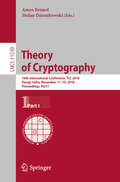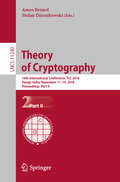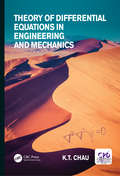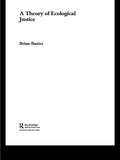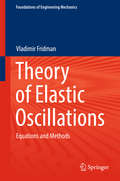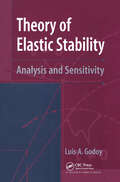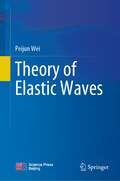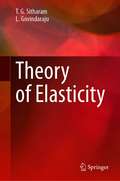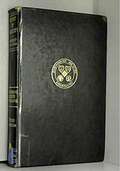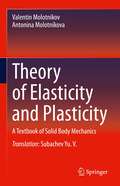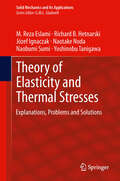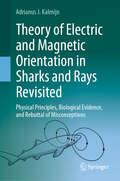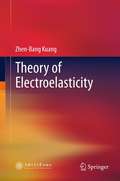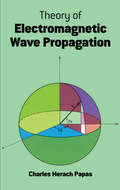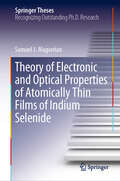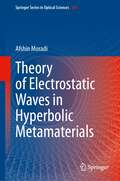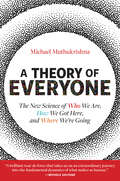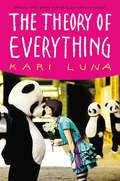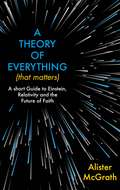- Table View
- List View
Theory of Computational Complexity
by Ding-Zhu Du Ker-I KoPraise for the First Edition "...complete, up-to-date coverage of computational complexity theory...the book promises to become the standard reference on computational complexity." -Zentralblatt MATH A thorough revision based on advances in the field of computational complexity and readers' feedback, the Second Edition of Theory of Computational Complexity presents updates to the principles and applications essential to understanding modern computational complexity theory. The new edition continues to serve as a comprehensive resource on the use of software and computational approaches for solving algorithmic problems and the related difficulties that can be encountered. Maintaining extensive and detailed coverage, Theory of Computational Complexity, Second Edition, examines the theory and methods behind complexity theory, such as computational models, decision tree complexity, circuit complexity, and probabilistic complexity. The Second Edition also features recent developments on areas such as NP-completeness theory, as well as: A new combinatorial proof of the PCP theorem based on the notion of expander graphs, a research area in the field of computer science Additional exercises at varying levels of difficulty to further test comprehension of the presented material End-of-chapter literature reviews that summarize each topic and offer additional sources for further study Theory of Computational Complexity, Second Edition, is an excellent textbook for courses on computational theory and complexity at the graduate level. The book is also a useful reference for practitioners in the fields of computer science, engineering, and mathematics who utilize state-of-the-art software and computational methods to conduct research. A thorough revision based on advances in the field of computational complexity and readers' feedback, the Second Edition of Theory of Computational Complexity presents updates to the principles and applications essential to understanding modern computational complexity theory. The new edition continues to serve as a comprehensive resource on the use of software and computational approaches for solving algorithmic problems and the related difficulties that can be encountered. Maintaining extensive and detailed coverage, Theory of Computational Complexity, Second Edition, examines the theory and methods behind complexity theory, such as computational models, decision tree complexity, circuit complexity, and probabilistic complexity. The Second Edition also features recent devnd complexity at the graduate level. The book is also a useful reference for practitioners in the fields of computer science, engineering, and mathematics who utilize state-of-the-art software and computational methods to conduct research.
Theory of Cryptography: 16th International Conference, Tcc 2018, Panaji, India, November 11-14, 2018, Proceedings, Part Ii (Lecture Notes in Computer Science #11240)
by Amos Beimel Stefan DziembowskiThe two-volume set of LNCS 11239 and LNCS 11240 constitutes the revised proceedings of the 16th International Conference on Theory of Cryptography, TCC 2018, held in Panaji, India, in November 2018.The total of 50 revised full papers presented in the proceedings were carefully reviewed and selected from 168 submissions. The Theory of Cryptography Conference deals with the paradigms, approaches, and techniques used to conceptualize natural cryptographic problems and provide algorithmic solutions to them and much more.
Theory of Cryptography: 16th International Conference, TCC 2018, Panaji, India, November 11–14, 2018, Proceedings, Part II (Lecture Notes in Computer Science #11240)
by Amos Beimel Stefan DziembowskiThe two-volume set of LNCS 11239 and LNCS 11240 constitutes the revised proceedings of the 16th International Conference on Theory of Cryptography, TCC 2018, held in Panaji, India, in November 2018.The total of 50 revised full papers presented in the proceedings were carefully reviewed and selected from 168 submissions. The Theory of Cryptography Conference deals with the paradigms, approaches, and techniques used to conceptualize natural cryptographic problems and provide algorithmic solutions to them and much more.
Theory of Decision under Uncertainty
by Itzhak GilboaThis book describes the classical axiomatic theories of decision under uncertainty, as well as critiques thereof and alternative theories. It focuses on the meaning of probability, discussing some definitions and surveying their scope of applicability. The behavioral definition of subjective probability serves as a way to present the classical theories, culminating in Savage's theorem. The limitations of this result as a definition of probability lead to two directions - first, similar behavioral definitions of more general theories, such as non-additive probabilities and multiple priors, and second, cognitive derivations based on case-based techniques.
Theory of Differential Equations in Engineering and Mechanics
by Kam Tim ChauThis gives comprehensive coverage of the essential differential equations students they are likely to encounter in solving engineering and mechanics problems across the field -- alongside a more advance volume on applications. This first volume covers a very broad range of theories related to solving differential equations, mathematical preliminaries, ODE (n-th order and system of 1st order ODE in matrix form), PDE (1st order, 2nd, and higher order including wave, diffusion, potential, biharmonic equations and more). Plus more advanced topics such as Green’s function method, integral and integro-differential equations, asymptotic expansion and perturbation, calculus of variations, variational and related methods, finite difference and numerical methods. All readers who are concerned with and interested in engineering mechanics problems, climate change, and nanotechnology will find topics covered in these books providing valuable information and mathematics background for their multi-disciplinary research and education.
The Theory of Direct Dark Matter Detection: A Guide to Computations (Lecture Notes in Physics #996)
by Eugenio Del NobileThis book is a pedagogical guide on how to make computations in direct dark matter (DM) detection. The theory behind the calculation of direct detection cross sections and rates is presented, touching aspects related to elementary particle physics, hadronic physics, nuclear physics, and astrophysics. The book is structured in self-contained sections, covering several topics ranging from the scattering kinematics to the phenomenology of direct DM searches. It follows a model-independent approach, aiming at providing the readers with all that is needed to understand the theory and start their own analysis. Meant for graduate students and researchers with interests in particle physics and phenomenology, it is enriched with several worked examples from standard and non-standard particle DM models. Senior researchers working in different areas related to dark matter, like particle and nuclear physics, astrophysics, and cosmology, find in this book a useful and updated guide for reference.
Theory of Dislocations
by Anderson Peter Martin Hirth John Price Jens LotheA basic text on defects in materials, emphasizing the fundamentals of dislocations and their applications to understanding physical phenomena. The new edition discusses recent discoveries in dislocation theory and includes new material on displacement fields of dislocations, atomic calculations, advanced anisotropic elastic theory, equations for the stress fields of loops, and grain boundary dislocations. Includes extensive treatment of the mathematics of dislocations.
Theory of Disordered Solids: From Atomistic Dynamics to Mechanical, Vibrational, and Thermal Properties (Lecture Notes in Physics #1015)
by Alessio ZacconeThis book presents a consistent mathematical theory of the non-electronic physical properties of disordered and amorphous solids, starting from the atomic-level dynamics and leading to experimentally verifiable descriptions of macroscopic properties such as elastic and viscoelastic moduli, plasticity, phonons and vibrational spectra, and thermal properties. This theory begins with the assumption of the undeniable existence of an “amorphous lattice”, which allows one to relegate the theoretical uncertainties about the ultimate nature of the glass transition to a subsidiary role and thus take a more pragmatic approach towards the modelling of physical properties. The book introduces the reader not only to the subtle physical concepts underlying the dynamics, mechanics, and statistical physics of glasses and amorphous solids, but also to the essential mathematical and numerical methods that cannot be readily gleaned from specialized literature since they are spread out among many often technically demanding papers. These methods are presented in this book in such a way as to be sufficiently general, allowing for the mathematical or numerical description of novel physical phenomena observed in many different types of amorphous solids (including soft and granular systems), regardless of the atomistic details and particular chemistry of the material. This monograph is aimed at researchers and graduate-level students in physics, materials science, physical chemistry and engineering working in the areas of amorphous materials, soft matter and granular systems, statistical physics, continuum mechanics, plasticity, and solid mechanics. It is also particularly well suited to those working on molecular dynamics simulations, molecular coarse-grained simulations, as well as ab initio atomistic and DFT methods for solid-state and materials science.
The Theory of Ecological Communities (MPB-57)
by Mark VellendA plethora of different theories, models, and concepts make up the field of community ecology. Amid this vast body of work, is it possible to build one general theory of ecological communities? What other scientific areas might serve as a guiding framework? As it turns out, the core focus of community ecology--understanding patterns of diversity and composition of biological variants across space and time--is shared by evolutionary biology and its very coherent conceptual framework, population genetics theory. The Theory of Ecological Communities takes this as a starting point to pull together community ecology's various perspectives into a more unified whole. Mark Vellend builds a theory of ecological communities based on four overarching processes: selection among species, drift, dispersal, and speciation. These are analogues of the four central processes in population genetics theory--selection within species, drift, gene flow, and mutation--and together they subsume almost all of the many dozens of more specific models built to describe the dynamics of communities of interacting species. The result is a theory that allows the effects of many low-level processes, such as competition, facilitation, predation, disturbance, stress, succession, colonization, and local extinction to be understood as the underpinnings of high-level processes with widely applicable consequences for ecological communities.Reframing the numerous existing ideas in community ecology, The Theory of Ecological Communities provides a new way for thinking about biological composition and diversity.
A Theory of Ecological Justice (Environmental Politics #Vol. 8)
by Brian BaxterIn A Theory of Ecological Justice, Baxter argues for ecological justice - that is, for treating species besides homo sapiens as having a claim in justice to a share of the Earth's resources. It explores the nature of justice claims as applied to organisms of various degrees of complexity and describes the institutional arrangements necessary to integrate the claims of ecological justice into human decision-making.
Theory of Elastic Oscillations
by Vladimir FridmanThis book presents in detail an alternative approach to solving problems involving both linear and nonlinear oscillations of elastic distributed parameter systems. It includes the so-called variational, projection and iterative gradient methods, which, when applied to nonlinear problems, use the procedure of linearization of the original non-linear equations. These methods are not universal and require a different solution for each problem or class of problems. However, in many cases the combination of the methods shown in this book leads to more efficient algorithms for solving important applied problems. To record these algorithms in a unified form, the first part of the book and its appendix devote considerable attention to compiling the general operator equations, which include (as particular cases) equations for vibrations in rods, plates, shells and three-dimensional bodies. They are mainly considered to be periodic or nearly periodic oscillations, which correspond to stationary or nearly stationary regimes of machinery operation. In turn, the second part of the book presents a number of solutions for selected applications.
Theory of Elastic Stability: Analysis and Sensitivity
by Luis A. GodoyThis book gives a unified presentation of the field of stability. Buckling and post-buckling states are studied on the basis of total potential energy of structural systems. Emphasis is placed throughout the text on post-buckling analysis and behaviour. The sensitivity of buckling and post-buckling states to changes in design parameters is also discussed as well as changes due to imperfections and damage.
Theory of Elastic Waves
by Peijun WeiThis book highlights a systematic introduction to the basic theory of elastic wave propagation in complex media. The theory of elastic waves is widely used in fields such as geophysical exploration, seismic survey, medical ultrasound imaging, nondestructive testing of materials and structures, phononic crystals, metamaterials and structure health monitoring. To help readers develop a systematic grasp of the basic theory, and thus its applications, the book elaborates on the theory of elastic wave propagation in isotropic solid media, covering phenomena in infinite media, interfaces, layered structure with finite thickness, Rayleigh wave and Love wave propagating along the surface of semi-infinite solid and covering layer, and the guided waves and leaky waves in flat plates and in cylindrical rods. The propagation patterns and features of guided waves in cylindrical shells and spherical shells are also introduced. The author wrote the book based on a decade of teaching experience of a graduate course of the same name and two decades of research on the theory and applications. The book is a valuable reference for students, researchers and professionals who expect an understandable and comprehensive discussion of the theory, analytical methods and related research results.
Theory of Elasticity
by T. G. Sitharam L. GovindarajuTheory of Elasticity provides a modern and integrated treatment of the foundations of solid mechanics as applied to the mathematical description of material behavior primarily to serve the needs of undergraduate, postgraduate and research students of Civil, Mechanical and Aeronautical engineering. Basic concepts, definitions, theory as well as related practical applications are discussed in a logical and concise manner. The book includes a pedagogical features such as worked examples and problems to consolidate the readers’ understanding of fundamental principles and illustrates their applications in many practical situations. An important feature of this book lies in the use of linear theory of elasticity to obtain solutions to some of the specialized problems related to soil mechanics and foundation engineering in particular.
Theory of Elasticity
by Stephen P. Timoshenko J. N. GoodierIn the revision of this book for a third edition, the primary intention and plan of the first edition have been preserved--to provide for engineers, in as simple a form as the subject allows, the essential fundamental knowledge of the theory of elasticity together with a compilation of solutions of special problems that are important in engineering practice and design. The numerous footnote references indicate how the several topics may be pursued further. Since these are now readily supplemented by means of Applied Mechanics Reviews, new footnotes have been added sparingly with this in mind. Small print again indicates sections that can be omitted from a first reading. <p><p>The whole text has been reexamined, and many minor improvements have been made throughout by elimination and rearrangement as well as addition. <p><p>From "Preface to the Third Edition," page vii
Theory of Elasticity and Plasticity: A Textbook of Solid Body Mechanics
by Valentin Molotnikov Antonina MolotnikovaThis book serves as a core text for university curricula in solid body mechanics and, at the same time, examines the main achievements of state of the art research in the mechanics of elastic and non-elastic materials. This latter goal of the book is achieved through rich bibliographic references, many from the authors’ own work. authors. Distinct from similar texts, there are no claims in this volume to a single universal theory of plasticity. However, solutions are given to some new problems and to the construction of models useful both in pedagogic terms for students and practical terms for professional design engineers. Examples include the authors’ decisions about the Brazilian test, stability of rock exposure, and pile foundations. Designed for both upper-level university students and specialists in the mechanics of deformable hard body, the material in this book serves as a source for numerous topics of course and diploma concentration.
Theory of Elasticity and Thermal Stresses: Explanations, Problems And Solutions (Solid Mechanics and Its Applications #197)
by Yoshinobu Tanigawa Naobumi Sumi Naotake Noda Józef Ignaczak Richard B. Hetnarski M. Reza EslamiThis book contains the elements of the theory and the problems of Elasticity and Thermal Stresses with full solutions. The emphasis is placed on problems and solutions and the book consists of four parts: one part is on The Mathematical Theory of Elasticity, two parts are on Thermal Stresses and one part is on Numerical Methods. The book is addressed to higher level undergraduate students, graduate students and engineers and it is an indispensable companion to all who study any of the books published earlier by the authors. This book links the three previously published books by the authors into one comprehensive entity.
Theory of Electric and Magnetic Orientation in Sharks and Rays Revisited: Physical Principles, Biological Evidence, and Rebuttal of Misconceptions
by Adrianus J. KalmijnThe book describes the theory of electromagnetic orientation in sharks and rays. The theory evolved from studying the publications of Faraday, von Arx, and Longuett-Higgins. Sharks and rays can detect the earth’s magnetic field as well as the ambient electric fields, utilizing their electrosensory system, the Ampullae of Lorenzini. Dr. Kalmijn provides the physical description of this sensory system in the context of his previously published behavioral studies performed in the laboratory and in natural, open-ocean settings. The book lays bare the physics bedrock of the motional electric fields.The physics of the entire sensory environment interacting with these very sensitive organs is made clear step by step so the reader can understand the source of the fields and how the animals detect them. Dr. Kalmijn analyzes the sensory organs from the perspective of the animal moving through these electric and magnetic fields to arrive at the appropriate relativistic frame to understand how the sensory system works. Relying on his thorough understanding of Maxwell, Faraday, and Einstein, he has sought to understand the miraculous abilities of Elasmobranchs.The detailed presentation clears away many of the misunderstandings and mistakes of previous researchers. Nearly all the mistakes pertain to the underlying physics. The existing literature is discussed, put in context, and corrected. This summary and final presentation of Dr. Kalmijn’s life-time study of electromagnetic reception in Elasmobranchs will surely be recognized as the definitive treatise in years to come. It gives researchers and students in biology, physics, oceanography, and fisheries a detailed mathematical physics background for the understanding of electroreception in Elasmobranch fishes.
Theory of Electroelasticity
by Zhen-Bang KuangTheory of Electroelasticity analyzes the stress, strain, electric field and electric displacement in electroelastic structures such as sensors, actuators and other smart materials and structures. This book also describes new theories such as the physical variational principle and the inertial entropy theory. It differs from the traditional method by using the physical variational principle to derive the governing equations of the piezoelectric material, whereas the Maxwell stress is obtained automatically. By using the inertial entropy theory, the temperature wave equation is obtained very easily. The book is intended for scientists, researchers and engineers in the areas of mechanics, physics, smart material and control engineering as well as mechanical, aeronautical and civil engineering, etc. Zhen-Bang Kuang is a professor at Shanghai Jiao Tong University.
Theory of Electromagnetic Wave Propagation
by Charles Herach PapasWhile there are so many books on general electromagnetic theory for graduate-level students, there are significantly fewer that concentrate on the radiation aspects as does this well-known work. Interfacing physics and electrical engineering, Dr. Papas's clearly written text discusses highly important topics in the theory of electromagnetic wave propagation and antennas in a way that reveals the inherent simplicity of the basic ideas and their logical development from the Maxwell field equation.Chapter 1: Maxwell's field equations and those parts of electromagnetic field theory necessary for understanding the remainder of the book.Chapter 2: How the dyadic Green's function can be used to compute radiation from monochromatic sources.Chapter 3: Problems of radiation emitted by wire antennas and antenna arrays from the viewpoint of analysis and synthesis.Chapter 4: Two methods of expanding a radiation field in multiples -- one based on the Taylor expansion of the Helmholtz integrals and the other, on all expansion in spherical waves.Chapter 5: Wave aspects of radio-astronomical antenna theory.Chapter 6: Theory of electromagnetic wave propagation in a plasma medium describing the behavior of an antenna immersed in such a medium.Chapter 7: Covariance of Maxwell's equations in material media and its application to phenomena such as the Doppler effect.By unifying various topics under the single mantle of electromagnetic theory, Professor Papas has made the contents of this book easy to learn and convenient to teach. In addition, the book assembles much data previously available only in scattered research literature. The result is a superb graduate-level text that can also lend itself to self-instruction by researchers.
Theory of Electronic and Optical Properties of Atomically Thin Films of Indium Selenide (Springer Theses)
by Samuel J. MagorrianThis thesis provides the first comprehensive theoretical overview of the electronic and optical properties of two dimensional (2D) Indium Selenide: atomically thin films of InSe ranging from monolayers to few layers in thickness. The thesis shows how the electronic propertes of 2D InSe vary significantly with film thickness, changing from a weakly indirect semiconductor for the monolayer to a direct gap material in the bulk form, with a strong band gap variation with film thickness predicted and recently observed in optical experiments. The proposed theory is based on a specially designed hybrid k.p tight-binding model approach (HkpTB), which uses an intralayer k.p Hamiltonian to describe the InSe monolayer, and tight-binding-like interlayer hopping. Electronic and optical absorption spectra are determined, and a detailed description of subbands of electrons in few-layer films and the influence of spin-orbit coupling is provided. The author shows that the principal optical excitations of InSe films with the thickness from 1 to 15 layers broadly cover the visible spectrum, with the possibility of extending optical functionality into the infrared and THz range using intersubband transitions.
Theory of Electrostatic Waves in Hyperbolic Metamaterials (Springer Series in Optical Sciences #245)
by Afshin MoradiThis book covers electrostatic properties of hyperbolic metamaterials (HMMs), a fascinating class of metamaterials which combine dielectric and metal components. Due to the hyperbolic topology of the isofrequency surface in HMMs, the so-called resonance cone direction exists, and as a result, propagation of quasi-electrostatic waves, or more commonly, electrostatic waves close to the resonance cone with large wave vectors, is possible. However, the investigation of electrostatic wave properties in HMMs is largely overlooked in most works on the subject, and the purpose of this monograph is to fill this gap. This book gives a thorough theoretical treatment of propagation, reflection, and refraction of electrostatic waves in HMMs of various dimensions and geometries. It will be of interest to students and researchers who work on electrical and optical properties of metamaterials.
A Theory of Everyone: The New Science of Who We Are, How We Got Here, and Where We’re Going
by Michael MuthukrishnaA blueprint for a better future that offers a unified theory of human behavior, culture, and society.Playing on the phrase &“a theory of everything&” from physics, Michael Muthukrishna&’s ambitious, original, and deeply hopeful book A Theory of Everyone draws on the most recent research from across the sciences, humanities, and the emerging field of cultural evolution to paint a panoramic picture of who we are and what exactly makes human beings different from all other forms of life on the planet. Muthukrishna argues that it is our unique ability to create culture, a shared body of knowledge, skills, and experience passed on from generation to generation, that has enabled our current dominance. But it is only by understanding and applying the laws of life—the need for energy, innovation, cooperation, and evolution—that we can solve the practical and existential challenges we face as a species. A Theory of Everyone attempts to provide solutions for the most pressing problems of our collective future, such as polarization, inequality, the &“great stagnation&” in productivity, and the energy crisis.Casting a bold and wide net, Muthukrishna&’s book is a must-read for anyone interested in a better future for ourselves and for generations to come.
The Theory of Everything
by Kari LunaOne part Libba Bray's GOING BOVINE, two parts String Theory, and three parts love story equals a whimsical novel that will change the way you think about the world. Sophie Sophia is obsessed with music from the late eighties. She also has an eccentric physicist father who sometimes vanishes for days and sees things other people don't see. But when he disappears for good and Sophie's mom moves them from Brooklyn, New York, to Havencrest, Illinois, for a fresh start, things take a turn for the weird. Sophie starts seeing things, like marching band pandas, just like her dad. Guided by Walt, her shaman panda, and her new (human) friend named Finny, Sophie is determined to find her father and figure out her visions, once and for all. So she travels back to where it began--New York City and NYU's physics department. As she discovers more about her dad's research on M-theory and her father himself, Sophie opens her eyes to the world's infinite possibilities--and her heart to love. Perfect for fans of Going Bovine, The Perks of Being a Wallflower, Scott Pilgrim vs. The World and The Probability of Miracles.
A Theory of Everything (That Matters): A Short Guide to Einstein, Relativity and the Future of Faith
by Dr Alister E McGrathOn 29th May 1919, British astronomers tested Einstein's theory of relativity by measuring the path of the stars travelling near the sun during an eclipse. On 7th November 1919, the results of that experiment were announced in London, proving Einstein's theory of relativity. A Theory of Everything (that Matters) has been written in celebration of this 100th anniversary. With the confirmation of Einstein's theories at the beginning of the twentieth century, our understanding of the universe became much more complex. What does this mean for religious belief, and specifically Christianity? Does it mean, as so many people assume, the death of God? In A Theory of Everything (that Matters) Alister McGrath - Professor of Science and Religion at Oxford University - explores these questions, giving an overview of Einstein's thought and scientific theories, including his nuanced thinking on the difference between the scientific enterprise and beliefs outside its realm. This groundbreaking book is for anyone intrigued by Einstein as one of the twentieth century's most iconic figures, who wants to know what his theories mean for religion, and who is interested in the conversation between science and religions more broadly.'An excellent study of Einstein's theories in relation to his beliefs about God' - starred review in PUBLISHERS WEEKLY

